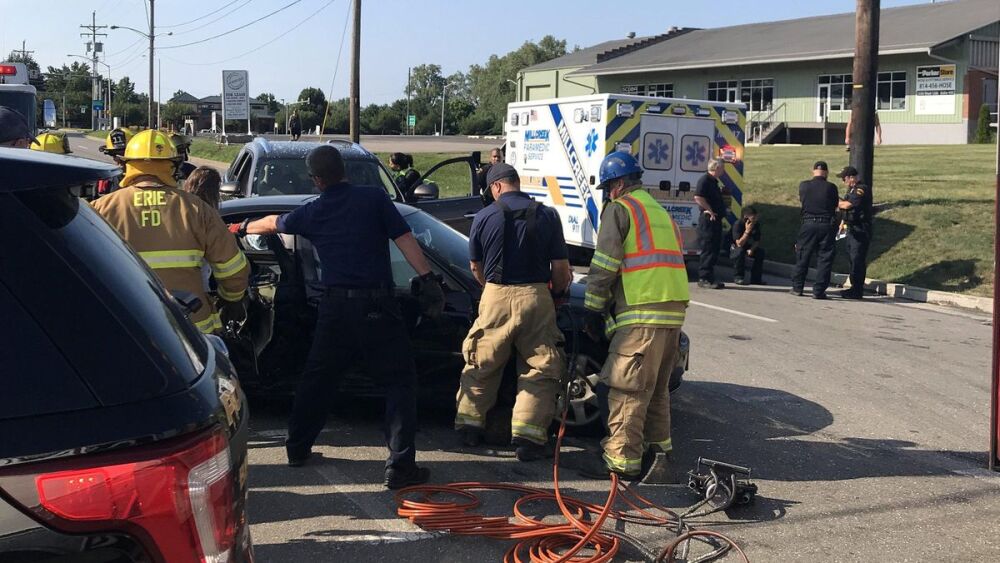Motor vehicle collisions (MVCs) – both big and small – are a commonplace call in many fire and EMS systems. We respond to them on congested and high-speed interstates, at city intersections, on rural roadways and even at round-abouts (turn circles or rotaries). For some, they’re almost a daily call occurrence. Regardless of your MVC call volume, let’s take a brief moment to do a bit of an MVC and vehicle safety check-in to keep us all on the same page (and safe, too!) with this 10-point MVC response safety checklist. [Fill out the form on this page to print out a copy of this checklist to keep for your reference]
1. Wear proper PPE
My hope by now is that donning safety glasses for all of your calls is routine, but if it’s not, then responding to MVCs is certainly one of the scenes where it should be. Along with your traffic safety vest, it’s important to wear other protective coverings, such as pants (rather than shorts) and a helmet (yes, even if you’re not a firefighter). While a minor fender-bender may not require all of these items, certainly more complex scenes should.
2. Block the scene
If you’re the first to arrive on scene with your ambulance, then use it to your advantage to increase your safety and that of your crew members as you work on scene. Use your vehicle as the scene’s initial blocker. When you’re on the side of the road, turn your wheels inward (toward the roadway), so that a rearward strike will send your vehicle into the roadway, rather than directly toward you and your workspace (and, don’t forget to park your vehicle on an angle, rather than straight-on, too).
3. Set-up perimeters
Just like with hazardous materials response calls, your cold zone is where the public will be, the warm zone is for other responders and hot zone is the immediate scene of the collision. Maintain privacy (hot), keep your resources close (warm), and allow for traffic to flow (cold).
4. Maintain visibility
Use your scene lights and carry a flashlight. There’s nothing worse than being on scene at night and not being able to accurately see what you’re dealing with. It’s important that we light up our scenes so that we can best assess our patients and provide any necessary on-scene treatments in the light (rather than in the dark).
5. Perform a 6-sided vehicle assessment
Front, rear, driver’s side, passenger’s side, top and bottom account for 6 sides of a motor vehicle. Look for door and support post intrusion, internal/external window damage, leaking fluids and for signs of vehicle rollover.
6. Make sure they’re in park
I would bet that nine out of 10 vehicles involved in a collision remain in drive upon your arrival. Even though they may not be moving anywhere (at the moment), ensure all vehicles are in park before you start putting yourself into harms’ way directly in front of or behind a vehicle that has lost some of its operational control functions.
7. Ensure stabilization
Flat tires are a good thing; they help to keep vehicles in place. Sloping roadways, on- and off-ramps to highways, overturned vehicles and any vehicle not in park has the potential to move – not just front-to-back, but also side-to-side (or over). Use step chocks, cribbing and/or struts to help keep vehicles safely in place.
8. Visualize before you cut
You wouldn’t blindly cut a newborn’s umbilical cord, so you shouldn’t start using hydraulic, pneumatic or electric power tools to cut apart any part of a vehicle without first exposing exactly what you intend to cut. The risk of rupturing air cylinders to inflate airbags, power lines to operate vehicle electronics, or even gas lines for vehicle that operate off of liquified petroleum gas is too dangerous of a risk to take.
9. Provide for cover
Cover patients, not just during extrication, but also to account for patient safety and comfort. Onlookers may be snapping pictures, and while they have the ability to do so, that doesn’t mean that you can’t proactively cover the patient in an effort to afford some level of patient privacy. Covering patients can also provide physical comfort, as MVCs certainly have a high occurrence during cold and snow-covered roadway months (or even during periods of rainfall). Disposable blankets and hospital blankets work great for all of these instances.
10. Account for all patients
Finally, make sure that you account for all possible patients, considering not only instances of patient ejection, but also for instances of patient walk-offs. Who is a patient, versus who is a party? Does everyone involved inside of any vehicle that was struck automatically become a patient (and, therefore, require a patient care report to be completed)? What do your protocols say regarding this? How about your agency/department policies, your director/chief and your medical director? When in doubt, if an individual was inside of one of the vehicles that was struck, you’re safer to consider them as a patient and document the event accordingly.
Read more
6 low- or no-cost ways to improve safety
Improve safety for you, your crew, your patient and your community with these simple strategies anyone can implement
Fill out the form on this page to download a copy of the 10-point MVC response safety checklist.
This article was originally posted June 1, 2021. It has been updated.




